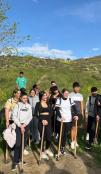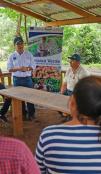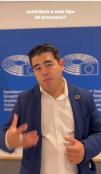EU and Latin America and the Caribbean: partners of choice for a changing world

From digital innovation to sustainable trade, cultural exchange to climate action, the EU and Latin American and Caribbean States (LAC) are working together to address global challenges and create opportunities for their citizens.
The EU-LAC partnership is not just about high-level diplomacy; it is about tangible results that impact people’s lives. The EU-LAC partnership is shaping a future that is inclusive, sustainable, and forward-looking. The two regions offers a model of cooperation that prioritizes people, the planet, and shared prosperity.
At the EU-CELAC Ministerial meeting in New York on 24 September, Foreign Affairs Ministers meet to shape the agenda of the next CELAC-EU Summit in Santa Marta, Colombia (9-10 November 2025) and review the state of the bi-regional relationship.
Now Foreign Ministers of both EU and CELAC members are ready to meet in New York, on the 24 September, side by side with the high-level week at the UN General Assembly to exchange on the progress made, priorities for the Summit and their cooperation in multilateral fora, hence paving the way to the Summit in November.
As EU High Representative Kaja Kallas emphasized in her speech at the European Parliament in February 2025, "Latin America and the Caribbean (LAC) is an indispensable partner in today’s world." The region stands as a cultural and democratic powerhouse, home to the planet’s richest biodiversity, including half of the world’s tropical forests. It is also a key ally in the fight against climate change, boasting an impressive renewable energy capacity—60% of its power mix, double the global average—and abundant critical raw materials essential for the green and digital transition.
The 2023 EU–Caribbean Leaders’ Meeting marked a renewed commitment to strengthening ties with the sub-region, paving the way for deeper dialogue and cooperation. The establishment of stronger links between the EU and Latin America and the Caribbean since then includes the European Commission President’s participation as a special guest in the 48th CARICOM summit, which took place last February in Barbados. The upcoming EU–Caribbean Leaders’ Meeting in Santa Marta will continue this momentum and carry the work forward.
The partnership with LAC is not just about shared values; it’s about shared action. Since the 2023 EU-CELAC Summit collaboration between both regions is guided by the EU-LAC Roadmap of Bi-Regional Initiatives and reinforced by high-level political engagement.
A dynamic political agenda
Since the 2023 Summit dialogue intensified, with over 30 EU high-level visits to the region, meetings, and progress on various agreements.
EU HR/VP Kaja Kallas has engaged extensively with LAC leaders, including Foreign Ministers from Costa Rica, Colombia, Uruguay, Barbados, Brazil, El Salvador, Guatemala, Honduras, Nicaragua, and Panama. These meetings have strengthened cooperation on climate action, digital transformation, security, human rights, and trade, as well as the EU-LAC Global Gateway Investment Agenda.

European Union, 2025
Image: HRVP Kallas with the foreign affairs ministers of Costa Rica, El Salvador, Guatemala, Honduras, Nicaragua and Panama.
The launch of the consultative coordination mechanism between the EU and CELAC created a platform to take stock of the progress in the implementation of the Summit commitments and to exchange on the wider partnership developments.
Championing multilateralism
The EU and LAC are staunch defenders of multilateralism and the rules-based international order. Together, EU and LAC countries represent nearly one-third of the votes at the United Nations and include seven G20 members. Collaboration between both regions takes place across critical global issues, from climate action and biodiversity protection to democracy, human rights, and digital governance.
Furthermore, EU and LAC are both committed to implementing the 2030 Agenda for Sustainable Development, reforming global financial architecture, and addressing transnational threats such as organized crime, drug trafficking, and cybersecurity risks.
The EU-LAC Digital Alliance: Connecting People, Driving Innovation
In today’s interconnected world, digital cooperation is essential for economic growth, social inclusion, and environmental sustainability. The EU-LAC Digital Alliance, launched in 2023, is a testament to the commitment of both regions to harness the power of technology for the benefit of their citizens.
The Alliance is built on a shared vision: a digital future that is sustainable, inclusive, and human-centered. It brings together 24 LAC countries and the 27 EU Member States to collaborate on a wide range of digital issues, from artificial intelligence (AI) and cybersecurity to e-governance and satellite technology.
From Connectivity to Innovation
One of the most significant achievements of the Digital Alliance is the BELLA submarine fiber-optic cable, the first direct digital connection between Europe and Latin America. This ground-breaking infrastructure has already connected 65 million people, from students and researchers to entrepreneurs and public institutions. By providing faster, more reliable internet access, BELLA is enabling new opportunities for education, business, and innovation.
The Digital Alliance is more than just connectivity. It’s about turning ideas into action. Through the EU-LAC Digital Accelerator, nearly 90 innovation partnerships have been established between European and LAC startups and corporations. These partnerships are driving solutions for some of the most pressing challenges, such as climate change, healthcare, and digital inclusion.
For example, the Copernicus Emergency Management Service is now supporting weather forecasting and natural disaster early warning in the Caribbean, one of the world’s most vulnerable regions to climate change. By using satellite data provided by Copernicus centre in Panama and the Copernicus centre in Chile, local authorities can better prepare for hurricanes and other extreme weather events, saving lives and protecting communities.
The success of the EU-LAC Digital Alliance lies in its pragmatic, results-oriented approach. Over the past two years, the Alliance has hosted ten high-level policy dialogues on critical digital topics, bringing together experts and policymakers from both regions. These discussions have led to concrete projects, such as the upcoming EU-LAC High Performance Computing Network, which will further boost AI development and scientific collaboration.
The Alliance is also expanding its reach. Four new countries have joined since its launch, and the BELLA cable’s terrestrial backbone is set to extend to Peru, Costa Rica, Guatemala, El Salvador, and Honduras in its next phase. This expansion will bring even more people online, fostering economic growth and social development.
Trade for Tomorrow: The EU-Mercosur, EU-Mexico, EU Central America and EU-Chile Agreements
Trade is a cornerstone of the EU-LAC partnership, and recent agreements are setting a new standards that benefits people and the planet. The EU-Mercosur Partnership Agreement and the EU-Mexico Modernised Global Agreement are not just about expanding markets—they’re about creating a fair, sustainable, and inclusive trade relationship. Central America is also benefitting from such modern agreements.
The EU-Mercosur Agreement
After years of negotiation, the EU and Mercosur (Brazil, Argentina, Paraguay, and Uruguay) reached a political agreement in December 2024. This historic deal will create the world’s largest free trade zone, covering nearly 800 million people and opening up new opportunities for businesses, farmers, and consumers on both sides.

European Union, 2025
Image: European Commission President Ursula von der Leyen with the Presidents of Brazil, Argentina, Paraguay and Uruguay.
The EU has committed €1.8 billion to support Mercosur’s green and digital transition, helping the region move toward sustainable agriculture, renewable energy, and innovation. This investment will not only boost economic growth but also ensure that trade is aligned with the Paris Agreement and the Sustainable Development Goals (SDGs).
The EU-Mexico Modernised Global Agreement
The EU-Mexico Modernised Global Agreement is another key milestone. This deal updates and expands the existing EU-Mexico partnership, covering everything from trade and investment to political cooperation and sustainable development.
Both agreements were proposed for signature and conclusion by the European Commission on 3 September 2025, marking a significant step forward in EU-LAC relations. They reaffirm the commitment of both regions to human rights, multilateralism, and international peace and security, while also addressing critical issues like transnational organized crime, migration, and gender equality.
The EU-Central America Association Agreement
In April 2024 the Council adopted the decision to conclude the agreement establishing an association between the European Union and its Member States and Central America. This was the final step of the ratification process of the agreement, through which the EU and Central America commit to a close, long-term relationship in all main policy areas. Its full entry into force will give an important impetus to the bi-regional relations, especially with the implementation of the political dialogue and the cooperation pillar.
The trade pillar of the association agreement has played an important role in promoting trade and investment between Europe and Central America. It has been provisionally applied since 2013.
The EU-Chile Advanced Framework Agreement
The EU-Chile Advanced Framework Agreement (AFA) is a modern and comprehensive partnership between the European Union and Chile. It modernizes and replaces the previous 2002 Association Agreement.
In 2023 with this agreement, Chile became the first country in LAC to concluding a next generation agreement with the EU, bolstering a renewed ambition in tackling present and future challenges, such as the 2030 Agenda, climate action, state modernisation, sustainable development and gender equality, as well as upholding our shared values and broadening our geopolitical cooperation.
The EU-LAC Cinema Campaign and People-to-People Exchanges
Culture has the power to bring people together, and the EU-LAC Cinema campaign is a perfect example of how art can foster understanding and collaboration. Launched as part of the EU-CELAC Bi-regional Roadmap 2023-2025, this initiative is all about celebrating diversity, promoting gender equality, and supporting young filmmakers from both regions.
From Festivals to Cinema Nights
The campaign kicked off with a focus on major film festivals, including Cannes, Berlin, Cartagena de Indias, Buenos Aires, Karlovy Vary, and Santiago de Chile. These events brought together producers, actors, directors, and students to showcase the potential of bi-regional co-production in the audio-visual sector.
But the campaign doesn’t stop at festivals. The next phase, EULAC Cinema Nights, will bring European and LAC films to audiences across both continents. Screenings will take place in different cities, creating a shared cultural experience that transcends borders.

European Union, 2025
Image: EU and Latin America and the Caribbean experts debating at the 59th Czech International Film Festival in Karlovy Vary
Journalists, academia and youth exchanges
Beyond cinema, the EU and LAC are also fostering people-to-people connections through media exchanges. Over the past three years, more than 60 journalists from 17 LAC countries have visited EU institutions in Brussels. These visits have given them a first-hand look at how the EU works, while also providing a platform for dialogue on geopolitical issues, media freedom, and the fight against FIMI and disinformation.
In 2024, LAC journalists were invited for the first time to the Connecting Media Communities event in Kosovo, where they joined over 100 media professionals from around the world to discuss Foreign Information Manipulation and Interference (FIMI). The EU also offered specialized training to LAC journalists and fact-checkers, sharing best practices and tools to combat disinformation.

European Union, 2025
Image: Journalists form LAC countries exchange with peers from international agencies, Brussels, 2025.
In June 2025, the fourth edition of the EU-LAC Youth Days was organised bringing together young leaders from Europe, Latin America, and the Caribbean to strengthen interregional dialogue and develop policy recommendations in the lead-up to the EU-CELAC Summit 2025. With this and other relevant events, the EU-LAC Foundation, supported by the EU, continued its valuable work in deepening bi-regional ties.
Moreover, through programmes such as Erasmus+ and Horizon Europe students, academics and researchers play a key role in building bridges between the EU and LAC.

European Union, 2025
Image: 2025 Erasmus scholars from Bolivia ready to set off for Spain, Germany, Italy, France and Belgium to pursue their Masters studies in technology, global studies and education for development.
EU HR/VP Kaja Kallas Kallas is keen to listen to youth ideas, views and proposals on the current global agenda. In 2025, she met a group of young activists coming from all continents, including LAC, to debate about EU foreign policy and global challenges at an EEAS-led youth policy dialogue.

European Union, 2025
Image: Young Colombian activist Maria Irene Silva meets EU HR/VP Kaja Kallas during the 2025 youth policy dialogue.
The €45 Billion Global Gateway Investment Agenda
The Global Gateway Investment Agenda (GGIA) is one of the most ambitious initiatives of the EU-LAC partnership. Launched as a result of the 3rd EU-CELAC Summit in 2023, the GGIA aims to mobilize €45 billion in investments to support sustainable, transparent, and high-quality projects in Latin America and the Caribbean.

European Union, 2025
The GGIA focuses on four key areas:
1. Fair Green Transition: Supporting renewable energy, sustainable infrastructure, and climate resilience.
2. Inclusive Digital Transformation: Expanding digital connectivity and promoting innovation.
3. Human Development: Investing in education, healthcare, and social inclusion.
4. Health Resilience and Vaccines: Strengthening healthcare systems and pandemic preparedness.
Turning challenges into opportunities
One of the most innovative projects under the GGIA is the transformation of the sargassum plague into an economic opportunity. Sargassum, a type of seaweed that has been devastating coastal communities in the Caribbean, is now being turned into a resource. The EU and its Member States are supporting research, innovation, and local workforce training to collect, manage, and repurpose sargassum for industrial use. This not only addresses an environmental challenge but also creates new jobs and economic diversification.
Another key focus is energy integration. The GGIA is supporting the development of regional energy markets in LAC, helping to connect and complement existing energy frameworks. This will enable the large-scale deployment of renewable energy, reducing dependence on fossil fuels and promoting sustainability. The investments backing the Digital Alliance, especially on satellite connectivity and high-capacity computing, are an important part of the GGIA.
Looking Ahead: The Road to the 2025 Summit
As the EU and LAC prepare for the Bi-regional Summit in Santa Marta, the momentum is clear. From digital innovation to sustainable trade, cultural exchange to climate action, this partnership is delivering real results that matter to people on both sides of the Atlantic.
The Foreign Affairs Ministers’ meeting in New York on 24 September will be a crucial step in shaping the agenda for the Summit. As both regions continue to work together, one thing is certain: the EU-LAC partnership is not just about the future—it’s about building that future today.
Join the Conversation
The EU and Latin America and the Caribbean are writing a new chapter in their partnership—and you’re part of it. Follow #CelacEUSummit2025 (EN) or #CELACUE2025 (ES) for the latest updates, share your thoughts on social media, and explore how you can be involved in this exciting journey.




